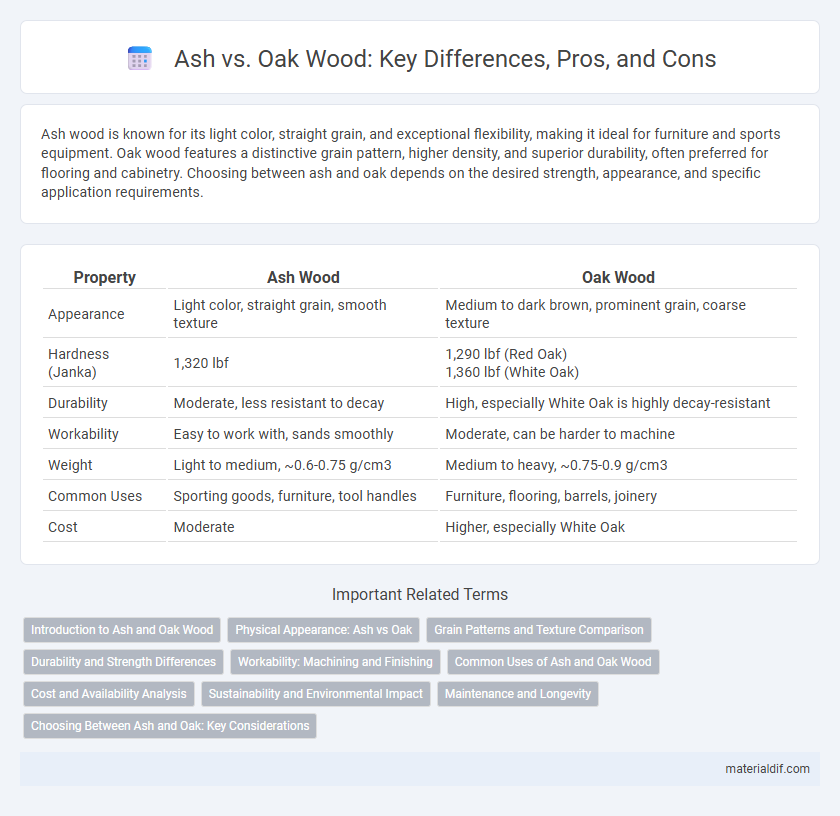Ash wood is known for its light color, straight grain, and exceptional flexibility, making it ideal for furniture and sports equipment. Oak wood features a distinctive grain pattern, higher density, and superior durability, often preferred for flooring and cabinetry. Choosing between ash and oak depends on the desired strength, appearance, and specific application requirements.
Table of Comparison
| Property | Ash Wood | Oak Wood |
|---|---|---|
| Appearance | Light color, straight grain, smooth texture | Medium to dark brown, prominent grain, coarse texture |
| Hardness (Janka) | 1,320 lbf | 1,290 lbf (Red Oak) 1,360 lbf (White Oak) |
| Durability | Moderate, less resistant to decay | High, especially White Oak is highly decay-resistant |
| Workability | Easy to work with, sands smoothly | Moderate, can be harder to machine |
| Weight | Light to medium, ~0.6-0.75 g/cm3 | Medium to heavy, ~0.75-0.9 g/cm3 |
| Common Uses | Sporting goods, furniture, tool handles | Furniture, flooring, barrels, joinery |
| Cost | Moderate | Higher, especially White Oak |
Introduction to Ash and Oak Wood
Ash and oak are both hardwoods prized for their durability and aesthetic appeal in furniture making and flooring. Ash wood is known for its light color and straight grain, providing flexibility and shock resistance ideal for sports equipment and tool handles. Oak offers a rich, coarse grain with exceptional strength and tannin content, making it highly resistant to fungal attacks and popular in cabinetry and wine barrels.
Physical Appearance: Ash vs Oak
Ash wood features a light, creamy color with a straight grain and a coarse texture, providing a uniform and smooth surface ideal for furniture and sports equipment. Oak wood exhibits a richer, golden to medium brown hue with prominent, complex grain patterns and a distinct coarse texture that adds character and durability to flooring and cabinetry. While ash offers a lighter aesthetic with subtle grain, oak presents a darker, more pronounced visual appeal, making each suitable for different design preferences.
Grain Patterns and Texture Comparison
Ash wood features a straight grain with a coarse, even texture that enhances its workability and finish. Oak displays a more prominent grain pattern, often with distinctive rays and flecks, providing a visually rich, textured surface. The contrast in grain details and texture between ash and oak influences their aesthetic appeal and suitability for furniture and flooring applications.
Durability and Strength Differences
Ash wood offers excellent shock resistance and flexibility, making it ideal for tools and sports equipment, while Oak is known for its superior hardness and density, providing greater durability for flooring and heavy furniture. Oak's tight grain and high tannin content contribute to its natural resistance against fungal attacks and wear, whereas Ash, though strong, is more prone to denting and moisture absorption. For applications requiring maximum strength and longevity, Oak is generally preferred due to its robust structural properties and enhanced lifespan under stress.
Workability: Machining and Finishing
Ash wood offers excellent workability due to its straight grain and moderate density, making it easy to machine and shape with minimal tearing. Oak, particularly red oak, has a coarser texture and higher density, which can result in more wear on tools during machining but provides a durable, smooth finish when sanded properly. Both woods accept stains and finishes well, though ash tends to produce a lighter, more uniform appearance while oak showcases prominent grain patterns that enhance the final finish.
Common Uses of Ash and Oak Wood
Ash wood is commonly used for tool handles, sports equipment such as baseball bats, and furniture due to its flexibility and shock resistance. Oak wood, prized for its strength and durability, is widely employed in flooring, cabinetry, and wine barrels. Both woods are favored in woodworking, but ash is preferred for items requiring elasticity, while oak excels in structural and decorative applications.
Cost and Availability Analysis
Ash wood generally offers a more cost-effective option compared to oak due to its faster growth rate and wider availability, making it a popular choice for budget-conscious projects. Oak, prized for its durability and rich grain, commands higher prices and is often sourced from older, slower-growing trees, which limits its availability. While both woods are durable, ash's lower cost and greater accessibility give it an advantage in large-scale or cost-sensitive applications.
Sustainability and Environmental Impact
Ash wood offers a faster growth rate and better carbon sequestration compared to oak, making it a more sustainable choice for timber production. Oak trees, while slower-growing, provide longer-lasting wood that reduces the need for frequent replacements, indirectly lowering environmental impact over time. Both species support biodiversity, but ash's adaptability to diverse climates and its ability to regenerate quickly enhance its role in sustainable forestry management.
Maintenance and Longevity
Ash wood offers moderate maintenance requirements due to its open grain structure, which may need regular sealing to prevent moisture damage, while oak wood is more durable with a tighter grain, making it naturally resistant to wear and decay. Oak typically outperforms ash in longevity, often lasting several decades with minimal upkeep, as its dense fibers provide enhanced strength and resistance to environmental stress. For projects demanding low maintenance and extended lifespan, oak is generally the preferred choice over ash.
Choosing Between Ash and Oak: Key Considerations
Selecting between ash and oak wood depends on key factors like durability, grain pattern, and workability. Ash offers a lighter color with a straight grain, making it ideal for furniture requiring flexibility and shock resistance, while oak is denser with a prominent grain, suited for heavy-use applications and high durability. Both woods exhibit excellent hardness, but oak's higher tannin content provides superior resistance to moisture and decay, influencing longevity in outdoor or high-humidity environments.
Ash vs Oak Infographic

 materialdif.com
materialdif.com